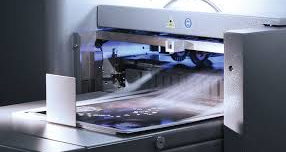
THIS IS A PROMOTIONAL ARTICLE PAID FOR BY KONICA MINOLTA
In April this year, Konica Minolta changed its Production Print division to a new business unit called Specialised Print, which brings together Production Print, 3D, Wide Format Print and a new group called Industrial Print. For Anthony Lewis, general manager of Specialised Print at Konica Minolta, the move is aimed at more accurately reflecting the division’s increasingly diverse products and services portfolio.
Anthony Lewis was appointed the division’s general manager in December last year. He says, “I asked the division’s managers whether we are the same today as we were five years ago. We agreed that, actually, we are not. We have changed.”
He says, “When we launched Konica Minolta production print in Australia seven years ago, we had a limited range
of offerings. Now, while we still do many of the things we have always done, we are also doing a whole lot more.”
Konica Minolta is already well known in the local market and further afield for its commercial-level bizhub range of printers. The company’s production print business also offers a range of 3D printers, finishing systems, inkjet textile printers, the KIP wide-format printers, and value-added industrial print solutions such as UV coaters.
With such a swag of products and services on offer, the Specialised Print business unit provides a better way to encapsulate the value that Konica Minolta’s print portfolio can offer its customers.
The new business unit sees five national managers report directly to Anthony Lewis. It heralds a new way of thinking about what Konica Minolta’s production print division can offer to the market, and a new approach to meeting customers’ needs.
Rather than taking the more traditional approach of simply working out how to sell products, the business unit will focus instead on how it can deliver value to customers through its offering, taking into account the company’s entire range of products and services across the board.
Anthony Lewis says, “We need to understand the value we can bring to the customer, and develop a sales strategy for each industry group or sector we service in the market. We want to make an effort to understand the pain points for each customer that we engage, and find out ways to help ease those. It is about supporting customers and helping them get the best possible returns out of their investments.
“To that end, we are moving away from the technicalities, like printer speeds and features, in the way we communicate to customers. Instead, we are moving towards identifying the elements that genuinely add value for our customers, so that helping customers is our core drive, not simply shipping printers.”
This goal is closely aligned with the goals laid out by Konica Minolta Australia’s managing director, Dr David Cooke, when his appointment was first announced in 2013. At the time, he said that he wanted Konica Minolta to be known as, “A company that truly cares about its customers and the community in which it operates”.
While the company’s customer-centric values-based approach is aimed at helping customers, there is an added benefit for Konica Minolta as well. By taking a more holistic approach to meeting customer’s needs, Anthony Lewis and his team will look beyond what their own business unit offers, and tap into the entirety of what Konica Minolta offers to meet customer needs.
Anthony Lewis says, “This new approach is valuable both to our customers externally, and to Konica Minolta internally. Doing it this way lets us add value to the divisions, and to other verticals in the market, too. We are going to be more integrated with the rest of the business, working with other business divisions to add value for the customers.
“Of course, we have an obligation to move a certain number of our units but, if we focus first on improving returns on investment for our customers, that will help drive unit sales as a natural result.”
Konica Minolta’s production printing division has a number of recent and soon-to-be-released products that it will be able to draw upon to add value for customers. These include the much-anticipated KM-1 B2 UV inkjet sheetfed press, the bizhub Press C71cf roll-to-roll continuous digital label printer, and the MGi JetVarnish 3DS, with spot and tactile varnishing capabilities.
While the bizhub Press C71cf was launched at Labelexpo in Brussels last year, Konica Minolta is waiting until the end of May to launch its KM-1 B2 sheetfed press, at the mother of all printing industry events, drupa. This is a fitting showcase, given that the formerly-quadrennial printing equipment exhibition in in Düsseldorf also played host to the very first public showing of the KM-1 back in 2012.
Since that first public showing, the B2 press, which was still in its development phase, has been through a lengthy trial period. Konica Minolta wanted to be comfortable with its performance and build up support infrastructure for the machine before moving into full commercial production.
Although KM-1 press will be launched at drupa this year, the Australian market will have to wait until the first quarter of next year before it becomes commercially-available. The team is keen to make sure there is a full-blown support network for the new printer before its local launch.
The release of the KM-1 will round out Konica Minolta’s high-end commercial production print offering in the Australian market. According to Anthony Lewis, the KM-1, along with the bizhub Press C71cf, the MGi JetVarnish 3DS, and another, as-yet-unnamed finishing machine that is due to be released later this year, will all play an important role in his division’s fresh focus on high-end digital production print.
Anthony Lewis says, “We’ve created a new industrial print business unit that is specifically designed to service the high-end market. This group will be in charge of products like the KM-1 and the C71cf. High-end is really our future, and commercial print is our primary focus, so the products managed by the industrial print group will be driving much of our future growth.
“For a long time now, we have had a solid track record in the mid-range production space. Now, we are beginning to see some traction in the high-end print market. But we have not always had the breadth of product offering to fully engage with that high-end. With these newer products, however, we finally have the ability to really increase value for companies in that market.”
The market for high-end digital commercial production print has become well-catered for by other companies over the past few years, and Konica Minolta is by no means the first vendor to release top-shelf products like the KM-1 B2 inkjet press in Australia. Yet Anthony Lewis is convinced that the superior quality of Konica Minolta’s machines will put the company well and truly at the forefront of the high-end market in Australia.
Lewis says, “What is our strength? As far as quality of print goes, our top- and mid-range production printing equipment is exceptional. Customers are looking for quality, reliability, and productivity. Konica Minolta’s products provide significantly better productivity in terms of output and print quality.
“The KM-1, for example, can take an enormous range of substrates, which is something that most other B2 inkjet presses in the local markets are not able to do. Combine this with the machine’s impressive print quality, and you have an offering for businesses looking for that combination.”
Another strength for Konica Minolta in the local market, according to Lewis, is its finishing capabilities. For many commercial production print businesses, a comprehensive finishing capability can spell the difference between selling on price and selling on product. Given how competitive the print industry is in Australia, a greater margin can often be generated by providing the finishing services to create a product, rather than just the printed sheet.
He says, “With our growing range of high-end finishing products, we now also have the offering to help businesses add value to their print output. Our strength is in additional finishing, meaning greater margins and more money for our customers.
“This is one of many ways in which our product-base serves our new value-focused approach to serving our customers. This is what we mean by Specialised Print, and why we think this new business unit better reflects what we do for companies in the local market.”
With this fresh focus and new approach to the business meeting business’s production print needs, Anthony Lewis and his team are gearing up to head off to Germany in May for drupa to show off their new wares.
It is shaping up to be a busy year for Anthony Lewis and company but, after just a few months in the role, it is an opportunity he relishes.
Comment below to have your say on this story.
If you have a news story or tip-off, get in touch at editorial@sprinter.com.au.
Sign up to the Sprinter newsletter


